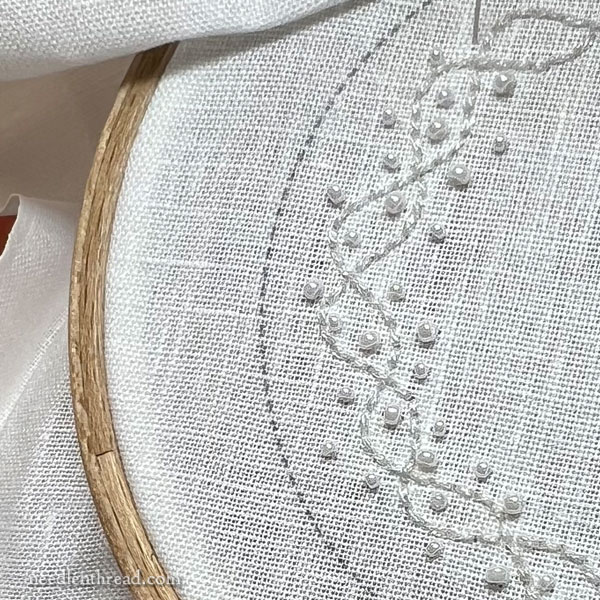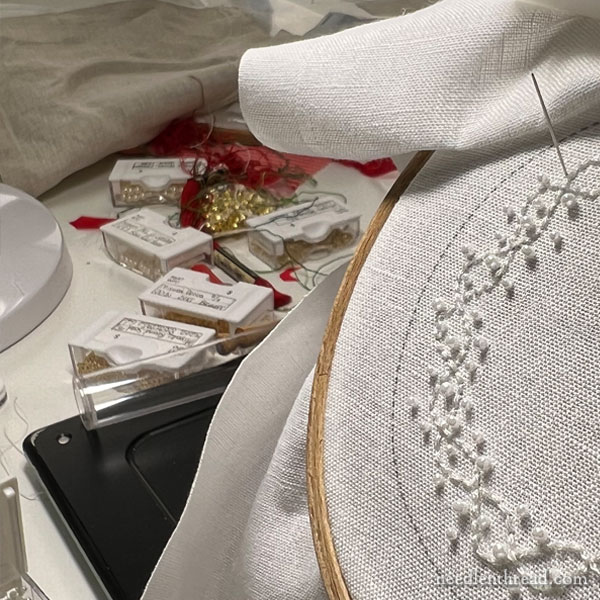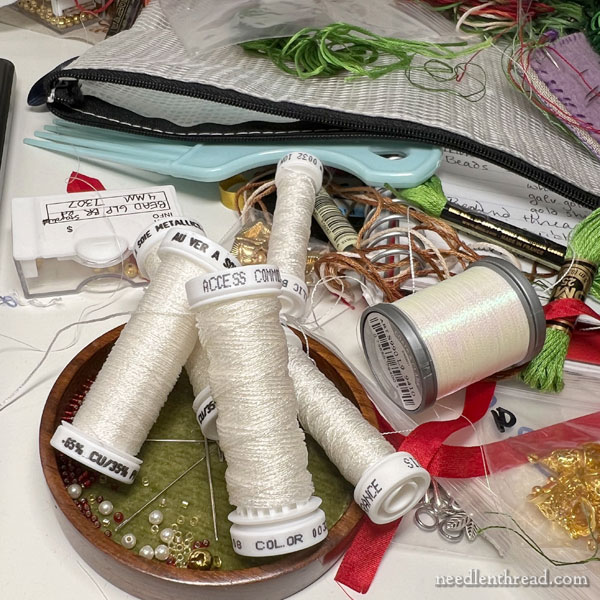I was going to title today’s article In Which I make Big Mess, and talk to you all about my current Big Mess.
But after last week’s article on incorporating beads in embroidery, a lot questions came in on different aspects of embroidery with beads. I think the answers to those might be more useful to you than a whole lot of chatter about my Current Big Mess. But I’ll use pictures of my Current Big Mess as illustrations and share some insights into the Mess, too.

This (above) was an experiment.
There’s a lot about it that I like. But for what I wanted it for, it’s actually a Fail.
Using metallics (I use Au Ver a Soie’s metallic threads, because they are the best metallic threads suited to hand embroidery, for all kinds of reasons which I discussed in this article once upon a time) and beads, I sought to create a kind of stardusty-snowy-sparkly-white-on-white approach on this little project.
I love the combination up close. But even bringing Christmas lights into the picture to gauge the glint and gleam of things, even from a short distance, the visual impact of the piece fades away.
So it doesn’t really work as an ornament, I don’t think. I’ll try approaching it a different way later.
Bead Types
The beads on that piece – as with most of the beads I use – are Miyuki seed beads. I use Miyuki beads predominantly because I think they are among the highest quality seed beads available today.
Miyuki beads are glass beads made in Japan. They are available a large range of colors, sizes, and finishes in their round seed beads (rocaille shape) and their Delica beads. Delicas are about the size of round seed beads, but they have straight cut edges. Imagine a bugle bead – like a long tube – but cut to the tiny size of a seed bead. That’s a delica.
Occasionally, I will also use TOHO beads.
Very rarely, I will use Mill Hill beads for some uses, but I don’t prefer them. I think they are overpriced for the quantity you get, and I’m not fond of their packaging (yes, I did devote a whole article to their bead packaging).
For pearls (not pearl-like seed beads, but round pearl beads) like the pearls shown in last week’s article, I have in the past always used Swarovski pearls. Now I use various types that I find through different sources. It just depends on what I’m looking for, what’s available, and the best quality I can find for the purpose or use. They are not real pearls, just so you know – although I have used real freshwater pearls in embroidery, and those, too, are sourced far and wide, depending on quality, size, quantity needed and available, and so forth.
Bead Sizes
For the most part, when I incorporate beads in embroidery, I use round seed beads or delicas in sizes 11/0 and 15/0.
In the photo above, the round seed beads (rocaille) are the same color and finish, but some are size 11/0 and some are size 15/0.
Occasionally, I will use larger beads – like an 8/0 or a 6/0 (the lower the number, the larger the bead) – when I’m using beads to accent an edging or something similar (like the beads used on the edge of Cotton Quartet, which you can see here).

I store all my beads in the bead container and tray sets I showed you in last week’s article.
On each container in the tray, I write the brand, the descriptive color and finish (ie, red garnet transparent silver lined, which I abbreviate “red garnet tnspnt SL”), the size (15/0) and the color number associated with the bead. Sometimes, I’ll include the source.

This is just another picture of my mess. I’m going to draw a lesson or tip out of it, though, so you don’t think it’s too random.
When I embroider with beads, I use a bead tray. You can see it under all those threads in the picture above. This particular little wooden tray comes from Jenny Adin-Christie in the UK. They’re a bit pricey but beautiful little trays made of wood and lined with velveteen. I also use them for chip work when doing goldwork embroidery.
You can easily make your own bead tray with a small, shallow tin lined with adhesive velveteen (you can purchase adhesive velveteen board through arts and crafts stores) or you can line it with a tacky bead mat, like I did when I made this portable bead tin for traveling and stitching on the go. I’ve even lined tins with wool felt to make a temporary bead mat – but felt is a bit too hairy, so I don’t prefer it.
Needles and Thread
When I embroider with beads, I use John James bead embroidery needles. These are shorter bead needles, used for embroidery (as the name suggests). They come in size 10 and size 12, and they come in sharp tips or tapestry tips. The size 10 works with 15/0 beads, when using beading thread, and this is the size I predominantly use and that I include in kits when beads are involved.
For beading thread, I use Miyuki nylon beading thread in white. I also use Nymo in size 0, 00, and B in white – they all work for embroidery with beads. While some folks are not keen on using nylon thread for embroidery with beads, I find it works well and it is the least visible on any color bead on any color ground fabric. It doesn’t dull the sparkle of the bead, as sometimes colored floss will do.
I have used matching floss (one strand) for bead embroidery, matching the floss to the color of the bead. In this case, I would usually wax the floss with beeswax, especially if using Delica beads, which tend to have a sharper edge.
I don’t often use floss anymore, though – I pretty much stick with Miyuki or Nymo nylon beading thread.
Bead Sources
I source my beads mostly through wholesale suppliers, since I usually kit with them.
When I buy them retail, I have ordered from the following online sources: Caravan Beads (they’re also a wholesale supplier), Fire Mountain Gems, Aura Crystals, Art Beads, and other sources.
Coming Up
So that’s the Bead Information and a glimpse of the Current Big Mess.
I’m sure there will be more mess to come!
I know I promised an upcoming article on lighting – it is coming. I’m just working out some kinks!
I’ll be showing you the new Design Collective book from Inspirations Studios – it focuses on Christmas designs! I will have a very limited stock of those books available in the shop, so if that book is on your radar, keep an eye out on Friday, which is when I will have it listed in the shop and when I will show you the book up close.
And now, I shall go back to the fun of weighing Lots and Lots of Beads! What’s that look like? It looks like this.







I don’t think I have seen this comment in your previous articles. I apologize if you have. When using the nylon thread for beading, I have read that it’s a good idea to stretch it before you use it. Just take the strand you are using and give it a good tug with your hands. This keeps it from stretching and loosening the beads later once sewn on. Thank you for sharing all your great ideas! Love reading your articles.
Thanks for the note! That’s really more for creating something out of beads, using the thread as the base construction material (like necklaces and so forth). Not as essential with embroider where you’re just adding occasional accent beads.
Mary-You hit the motherlode of seed beads! I thought that some vendors let go of seed beads because they’re no longer trending, but boy; the seed bead stock is up-and-running with these suppliers!